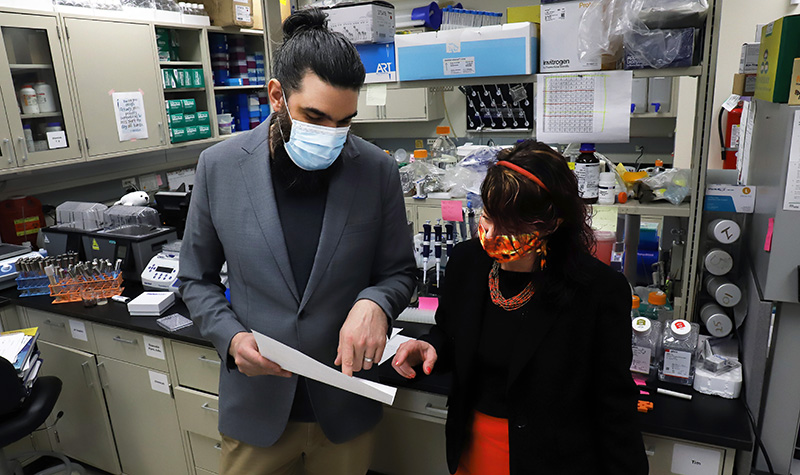.jpg)
Photo: Catherine Brissette, UND biomedical sciences associate professor. Credit @ Patrick C. Miller/UND Today. To read the full article on UND Today, click here.
Global Lyme Alliance research at UND could provide leads for COVID or other diseases.
Is there a connection between why some people with Lyme disease and some with COVID-19 experience long-term effects to their central nervous systems?
Known as neurological Lyme disease (NLD), the condition affects about 10% to 20% of those who contract the infection after being bitten by black-legged deer ticks. Rather than recovering from the disease, they continue to experience such symptoms as severe headaches, brain fog, facial paralysis, sensitivity to light and memory loss.
What’s learned about the similarities between the long-lasting effects of Lyme disease and COVID could apply to other infectious diseases as well.
UND researchers Catherine Brissette, associate professor of biomedical sciences in the School of Medicine & Health Sciences, and Timothy Casselli, research assistant professor, are developing a model with funding from the Global Lyme Alliance they believe can help answer these questions.
“There’s a lot of interest in this now because of long COVID,” Brissette noted. “But there are probably other infections in which you have a post-infectious syndrome where people have brain fog and fatigue and a constellation of symptoms of not feeling like they’re back 100%.
“We hope our research will help add some clues as to why people have those kinds of things,” she added. “I actually think it’s broader than Lyme disease.”
COVID connections
The similarities between NLD and “long COVID-19” patients – also called “long haulers” – who suffer damage to their lungs, hearts and brains months after contracting the virus was discussed in a November 2020 article by Mayla Hsu, GLA’s former director of research and science.
“The science underlying both illnesses is still being learned,” she wrote. “And it’s increasingly recognized that a subset of Covid-19 patients, like Lyme disease patients, suffers long-term debilitating symptoms that may take months or even longer to lift.”
The Borrelia burgdorferi bacteria that causes Lyme disease is transferred from ticks to humans or other host animals. First discovered in the 1970s on the East Coast, the disease has spread throughout the United States and the world with 476,000 known cases in this country annually.
The model under development at UND uses mice to understand how the bacteria interacts with the host to create different manifestations.
“This is to develop an understanding of the basic mechanisms on how an infection that doesn’t appear to directly get into the brain can still have effects on the brain,” Casselli explained. “We don’t have a good understanding of how that happens with Lyme disease because up until this point, we haven’t had a good model for testing.”

Timothy Casselli, research assistant professor, and Catherine Brissette discuss Lyme disease research data. Photo by Patrick C. Miller/UND Today.
Understanding what causes neurological problems in people who don’t have a brain infection is one aspect of the research that could be useful in developing new treatments.
“In the course of our research, we might find clues,” Brissette said. “We might find biomarkers – molecules that predict how someone might have problems down the line. In the long term, this research could lead to differences in treatment and perhaps diagnostics as well.”
To read the rest of the article, click here.






-2.jpg)
